Peonies in landscape design
Peonies are in great demand in landscape design and their lush bushes can add charm and beauty to any landscape due to the rich colors of flowers. This plant does not require any special conditions for growing and takes root easily on many types of soil with the necessary care.
Breeders managed to breed about 6 thousand varieties of peonies, which have different forms of bushes, shades of petals, size of buds and flowering periods. Such a variety of peonies makes it possible to actively use them in landscape design, creating chic compositions that will become a worthy decoration of any site.
Planting and caring for peony seedlings (with video)
If the planting of peonies will be carried out in August, then they can be sown directly into the ground. If the seeds are sown for seedlings in winter, then in this case a two-stage stratification is artificially carried out. For this purpose, you will need a heating pad with a thermostat in order to adjust the daily temperature fluctuations by switching.
How to plant peony seeds and care for seedlings? Seeds are sown in small containers in moistened sand and placed on a heating pad. During the month, the temperature of warming up during the day is increased to 30 ° C, and at night it is reduced to 15 ° C. The sand in which the seeds germinate is periodically moistened with a spray bottle. As soon as the roots appear, proceed to the "cold" stage.
At this stage, the seeds that have hatched are transplanted into boxes with fertile soil (peat cubes can be used). For them, the temperature is reduced to 5-10 ° C. With the appearance of the first leaves, the seedlings are transferred to a warm place (18-20 ° C).
Planting and caring for peonies in the open field begins in the second half of August.
The crops are monitored every day, watered or sprayed if necessary. The topsoil should always be moist (not wet!). How to care for peonies when shoots appear? In this case, the boxes are immediately opened and placed in a bright place.
In late March - early April, the boxes are placed on a well-lit windowsill. In winter, when many crops do not have enough natural light, the boxes are supplemented. They are placed on shelves equipped with special lighting lamps.
When caring for peonies, you need to constantly monitor the seedlings, water them regularly and moderately, avoiding waterlogging or drying out of the soil.
If some plants suddenly get sick, then they are removed, and watering is reduced. When the soil surface dries up (watering is performed only along the edge of the box), it is sprinkled with fine dry calcined sand, ash or crushed coal. If the spread of the disease cannot be stopped, then healthy seedlings dive into fresh soil, which is pre-treated with fungicides (chemicals used to fight fungal plant diseases). Fungicides include Bordeaux liquid, sulfur color, etc. They are also used for seed dressing.
Seedling picking. When the seedlings have 1-2 true leaves, they are dived into special cassettes. The size of the cassettes can be 5-8 cm.
Watch a video on how to care for peony seedlings in the country:
More reasons - due to diseases of peonies
Why don't peonies bloom on the site? Sometimes this happens when a disease is involved. Actually, this plant is quite disease resistant.
Gray rot
But it can be affected by botrytis (gray mold), which is manifested by the coating of green parts with gray mold. Around mid-May, bushes affected by this disease show signs of stem rot.The appearance of this disease is facilitated by high humidity in rainy weather, thickening of the planting of peonies and an excess of nitrogen in the soil.
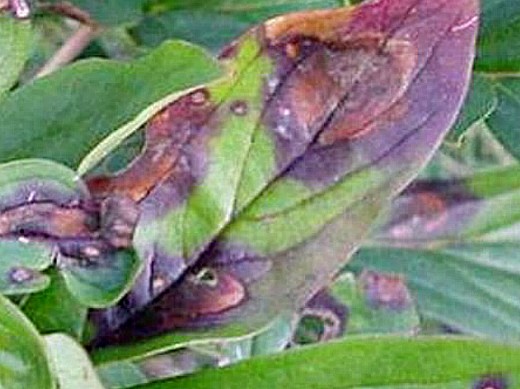
How to fight
To prevent disease, spray the bushes with garlic water (10 g of chopped vegetables / 1 liter of water) or suitable fungicides. We spray with any of these means not only the flowers, but also the ground under them. When signs of a disease appear, the stems are cut to the very root, and the plant residues are burned outside the site.
Powdery mildew
Peonies can also be affected by another fungal disease - powdery mildew, which manifests itself as a white bloom on the leaves.
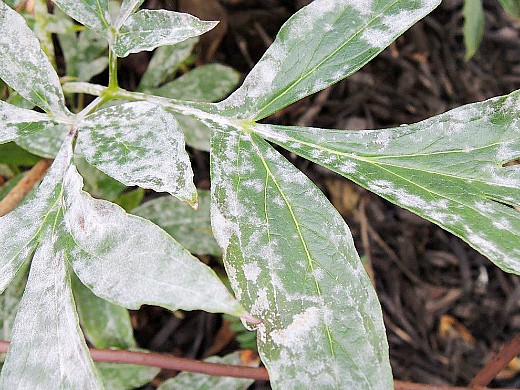
How to fight
We fight this disease using a special solution made from laundry soap (200 g) and copper sulfate (20 g), diluted in 10 liters of water.
Outdoor peony care
Each plant needs the care it requires. For the well-being of peonies, it is necessary to comply with its requirements for watering, weeding and feeding.
Watering
Regular watering in moderation is important for the plant, about 5-10 liters per bush once a week. During dry and hot weather, the volume of water can be increased. It is necessary to remember that you need to water at the root. Leaves can get burned if water gets on them. In the fall, watering can be minimized.
Weeding and loosening
One of the needs of peonies is the regular weeding of the soil. Removing weeds will have a positive effect on the growth and development of flowers, its appearance.
It is especially important to remove sow thistle and creeping wheatgrass.
With proper care of peonies, they will begin to bloom in late May - early June.
Features of care during flowering
The plant begins to bloom from about three years of age. When the bud is about the size of a pea, you can begin the pinching process. You need to pluck out the side shoots, leaving only one central one on each stem. This will stimulate the plant to bloom.
Cultivars that bloom in large inflorescences may not support the weight of the buds and fall to the ground, especially during the rainy season. For these varieties, special metal or plastic supports are used. When the peduncle finishes flowering, it must be cut off at a height of 15 cm from the ground.
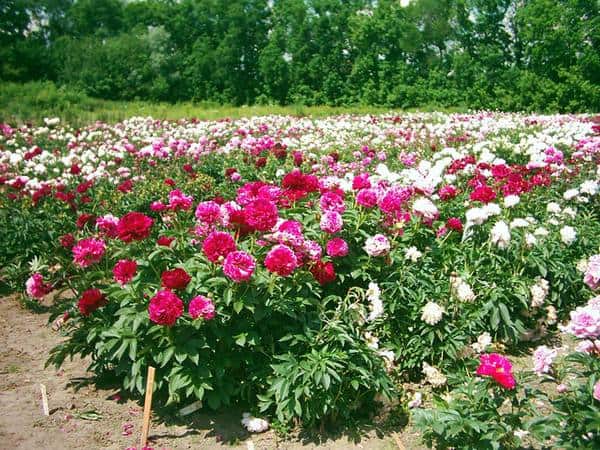
Transplant and reproduction
Although a garden peony is a perennial plant, from time to time it needs to be transplanted to another place. This is done approximately every 5-6 years. The transplant can be done in spring or autumn. But the flower will survive the autumn transplant better than the spring one.
After the spring transplant, the peony can adapt to the new environment for a long time and not bloom. A peony transplanted in the fall will have time to get used to the new soil and will already actively grow in the spring.
Top dressing
After winter, young peonies planted in the fall need not be fed. At this time, their roots are actively developing and growing, so they cannot fully assimilate mineral fertilizers. Only foliar dressings are recommended for use. To do this, you can buy complex fertilizers, for example, Baikal-M or Kemira.
In the spring, when the peony is actively increasing its green mass, it can be sprayed using Agricola. It must be used according to the instructions. In June, you can fertilize with Ideal (2 tablespoons per bucket of water).
From the second year, the peony is fed systematically:
- In May, spread compost or humus around the bush;
- To feed the roots, nitrogen fertilizers are used (for example, urea, 1 tablespoon of which must be diluted in a bucket of water;
- During the period of peduncle formation, liquid organic fertilizers are used, most often mullein;
- Buds and leaves can be sprayed with Bud;
- Pour a couple of glasses of ash next to the stems;
- After flowering, water with a solution of superphosphate and potassium sulfate.
Diseases and pests
Garden peonies most often suffer from botrytis - gray rot. Rotting stems, which begins in mid-May, are considered signs of the disease.Rot can affect both leaves and buds, they are covered with gray mold. This disease can develop due to an excess of nitrogen, rainy weather and tightness in the flower bed. All affected areas of the plant must be cut off and burned. To prevent the disease, you can spray the bush with a solution of copper sulfate or garlic water. You need to spray both the plant itself and the soil around it.
The plant can become infected with powdery mildew. This is a fungal disease that infects the leaves and covers them with a white coating. To combat this disease, the bush is sprayed with a solution using laundry soap and copper sulfate.
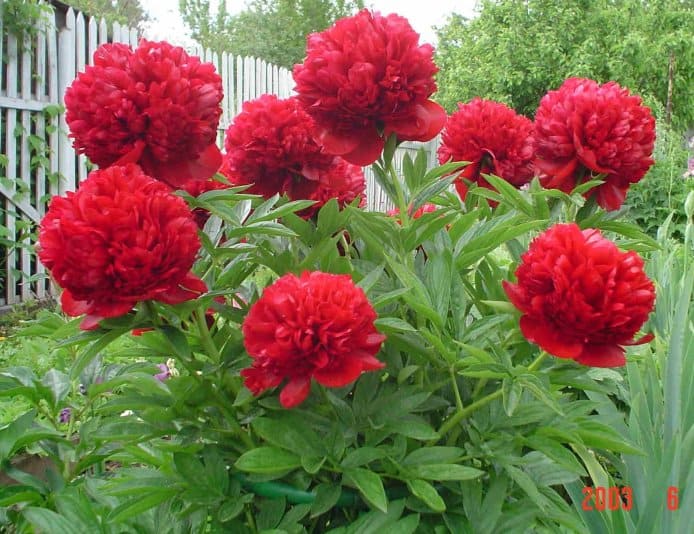
Peony is one of the most beautiful garden flowers. With proper care, it will delight with stunning lush blooms. Also, peony flowers look great in bouquets.
Care of young peonies after planting
Throughout the season, the plant experiences planting stress. Therefore, you need to know how to care for peonies. They should definitely be watered, fed, pruned.
Watering
After the autumn planting, it is necessary to water the bushes 2-3 times in the next month - before the frost begins. In the spring, peonies need frequent watering. It can even be daily. Then the amount of soil moisture depends on the weather. It is better to water the flowers in the morning or in the evening.
Fertilizer
For 2 years, the young peony will have enough fertilizers that were introduced into the recess during planting. After the end of this time, feeding is carried out with the arrival of spring - immediately after awakening. In summer, the bush should be fertilized with mineral fertilizers and organic matter.
Mulching
After planting, the bush must be covered with a mulch layer. It can include some kind of organic matter in the form of peat, sand or compost. With the help of these products, it will be possible to retain moisture and protect the bush from weeds.
First cut
After the first flowering, the bush should be cut off. Thanks to this, he will not waste energy on the formation of seed pods. At the same time, it is not recommended to cut the stems too short - a few leaves should remain below. This will help form replacement buds in late summer.
Important! With the arrival of cold weather, it is imperative to prune branches. This needs to be done up to 10 cm in height.
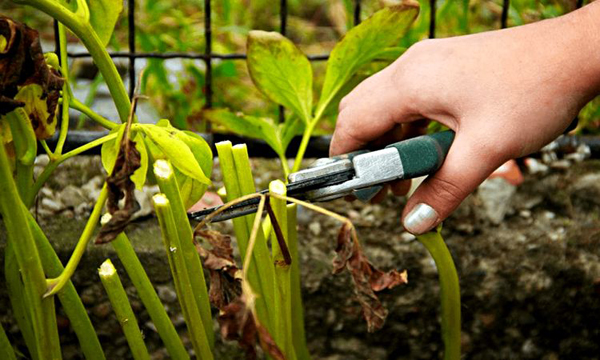
Peonies need correct and timely pruning
Preparation for wintering
When foliage and branches turn yellow, watering should be reduced a little. With the onset of frost, the ground part of the bush should be cut off. This must be done almost to the ground level.
Be sure to cover the bed with a mulch layer of peat. It should be 5-7 cm. This will help the plant survive the winter. With the arrival of spring, the beds must be opened immediately.
To achieve lush and abundant flowering, you need to know how to grow peonies. Plants need proper planting and careful care. In this case, the culture must be watered, cut, tied up in a timely manner. For the winter, the bush should be covered with a mulch layer. It can consist of peat or compost. With the arrival of spring, the shelter must be removed immediately.
Planting in open ground, feeding and fertilizing
Having decided to take care of such plants as peonies, you need to know how to properly care for the bushes, how the irrigation schedule differs, what fertilizers and fertilizing are recognized as the best and most effective.
Before planting a bush in open ground in the place where the peony will grow:
- They make a hole in the ground with a depth of 50-60 cm.
- Expanded clay is placed on the bottom with a layer of 10-12 cm.
- A layer of fertile soil is poured on top (a mixture of peat, bone meal, wood ash and ordinary garden soil).
- The seedling is lowered and covered with ordinary garden or vegetable garden soil.
To strengthen the roots of the peony, to activate all processes that contribute to the rapid growth and development of the flower, fertilizing will help, including the necessary microelements:
- The first is carried out immediately after the snow melts. The gardener will need nitrogen and potassium taken in equal amounts (15-20 g each).After mixing the components, the powder is scattered around the bush, being careful not to fall on the leaves. The mixture can cause burns on their surface.
- The second is during the budding period. Now, phosphorus is added to the already known potassium and nitrogen, changing the ratio. The components are taken in the amount of 12, 15 and 10 g, respectively. Spread the prepared mixture gently on the ground, protecting the leaves and stems of the plant.
- The third feeding should be carried out after the flowering period ends and flowers that have lost their attractiveness fall from the bush. Now the ground around the bush is sprinkled with a mixture of 20 g of potassium and 15 g of phosphorus, as before, trying not to harm the leaves and stems.
> Three additional fertilizing is not enough to prolong the life of a peony and make its existence on the site comfortable.
It is important to comply with all manufacturer's requirements in the process of preparing mixtures or diluting dry ingredients in the right amount of water.
Agrotechnics
Mostly irises bloom in the spring, but there are varieties that begin their flowering closer to summer, some specimens bloom again in the fall season. The most massive flowering occurs in the 3rd year after planting in a permanent place.
Blooming irises
Irises are unpretentious to care for and are not afraid of frost. Because of this, they are quite often planted in the city. The most optimal time for planting is autumn, therefore, after flowering, they are dug out, divided, then planted in new places.
Important! The name iris hides, though similar in appearance, but different flowers: rhizomatous and bulbous irises. The bulbous variety includes three subspecies: xyphium, iridodictium and juno, each with different characteristics.
Planting flowers
Rhizome irises are very fond of sunlight, so they develop well and bloom profusely precisely with the required amount of light. Despite this, they grow well in shaded areas, but they do not bloom so profusely.
When choosing a place for planting bushes, you should determine a part of the site where the soil is not heavy and moisture passes well. Water stagnation will cause the rhizome to rot.
Healthy. When buying, it is worth choosing large rhizomes, since they contain the most necessary substances for speedy growth. In addition, if there are about 7 leaves on the plot, the iris will be able to bloom next year in the spring. Then it is advisable to start landing them at the end of the summer season. They can also be transplanted to a new location in the open field and separated during flowering or when it ends - this is the best option.
Although the flowers are unpretentious, you should not plant them in heavy soil. It is better to add sand and peat there, then dig it up. If the soil is depleted, it is necessary to add a fertilizer with a low nitrogen content to it. The sour soil of irises is also out of sorts, although there is an overgrowth of green mass, but they may bloom sluggishly or not bloom at all. Such soil can be neutralized with ash.
On a note. If the site has a high level of groundwater, drainage should be arranged. This avoids the risk of root rot.
The soil must be dug onto the bayonet of the shovel. If necessary, top dressing should be applied a week before planting. The hole should not be deep so that the bud remains at ground level; when planting, the leaves should be vertical. For further growth, it is necessary to leave about 40 cm between the bushes. After planting it needs to be watered, next time it needs to be watered after 3 days have passed. If it is necessary to preserve the planting material, it must be left in a cool, dry place that is well ventilated.
Planting irises
Bulbous irises are thermophilic, they like heated, loose soil. Varieties of this species love dry places, therefore they require the least moisture. Their landing can be carried out in central Russia, starting from mid-September, in the southern regions - from mid-October.For wintering, seedlings should be covered with covering material.
Care after landing
Minimal care for rhizome species
After planting, the first time you need to pull out the weeds by hand, you need to loosen the soil carefully, since the roots lie at the very surface of the earth. When the flowers grow, loosening and weeding is no longer required
Important! In late autumn, the bushes must be completely trimmed. After removing the leaves, the soil must be loosened, then wait a short time so that it dries slightly, if it is very wet. Then add special flower mineral additives, after which soil is required to loosen again.
The rhizomes and bulbs are thus supplied with the nourishment required for wintering.
Then add special floral mineral additives, after which soil is required to loosen again. The rhizomes and bulbs are thus provided with the nourishment required for wintering.
On this, you need to continue to care for the plants and cover them so as not to damage the root system, which is located at the very top of the soil.
Post-flowering care
Caring for irises after flowering begins with pruning the peduncles. This will keep the planting decorative. There is no need to prune the leaves at the same time, this can be done a little later (with the appearance of the first significant frosts), when the plant is preparing for winter.
Irises - care after flowering


